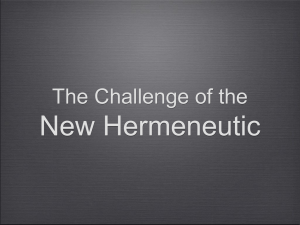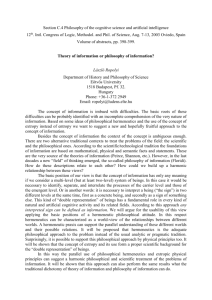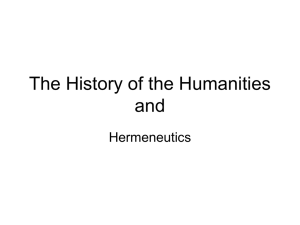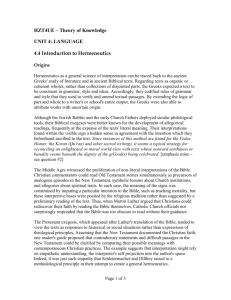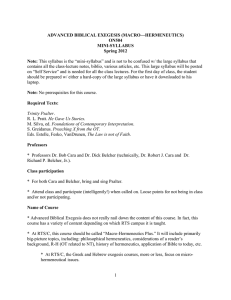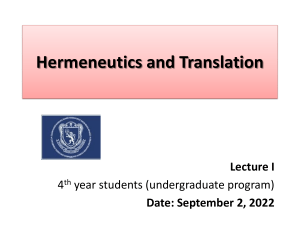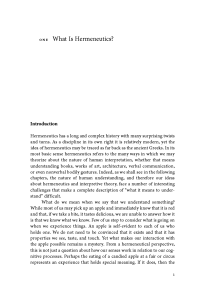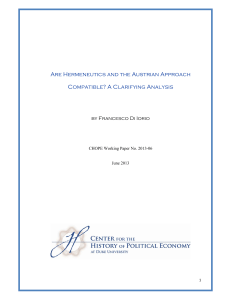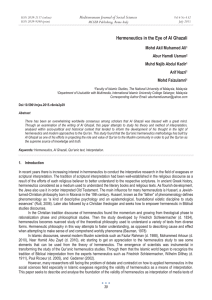Critical success factors of residential child and youth care in Ireland
advertisement
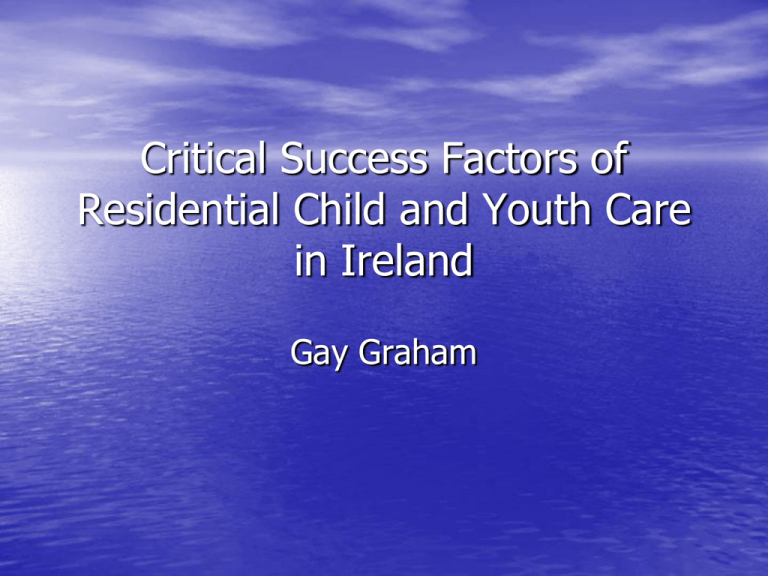
Critical Success Factors of Residential Child and Youth Care in Ireland Gay Graham Constructivist paradigm • Constructivism sees reality as relative to a particular way of understanding. • Knowledge is situation and time determined • Derived from interpretation - not value free. • Knowledge of key success factors in Ireland’s residential youth care likely to be derived from the perspectives of key players in the sector within a particular time frame Hermeneutics • Meaning making in life space encounters • Understanding through interpretation • There are 4 factors of hermeneutics that are significant to a better understanding of practices in Irish residential child and youth care Factors of Hermeneutics (1) • Interpretation: (as meaning) is the core of hermeneutics. • Our reality is based on our interpretations • To understand another person we need to recognise and take into consideration their meanings Factors of Hermeneutics (2) • Connectedness: Understanding young people (or staff) requires uncovering something of their connections to particular contexts • We use family and other background information to gain a better understanding of young people in our care Factors of Hermeneutics (3) World: • The context of one’s being and the social forces that shape it constitute one’s world • Behaviour is influenced by one’s perception of one’s environment or world • To understand children and influence their behaviour we must gain insight into their perception of their world and recognise what triggers their actions Factors of Hermeneutics (4) Time: • ¨Meaning making¨ is specific to particular points in time • In our work with children in their lifespace it is necessary to consider the factors presenting at a given time in order to respond sensitively to them Specifications of Hermeneutics • Concerned with understanding human experience as lived by the participants of that experience • Investigator is a central player in the research experience • Inductive (participative) paradigm rather than a hypothetical/deductive (abstract) paradigm • Use of tacit or experiential knowledge Sampling • Purposive Sampling (Patton 1980) • Neither representative nor random • Maximum Variation Sampling • Serial selection: the data collected from early participants analysed prior to selecting next participants • Contingent selection: succeeding participants are chosen for their differences and in ways that best serve the inquiry at that moment The Hermeneutic Circle • Understanding involves reference to what is already known, operating in a circular fashion • The Circle has two arcs: a forward Arc of Projection and a return Arc of Validation • The Arc of Projection involves a worker engaging with & reading particular situations from an informed, knowledge perspective • The Arc of Validation requires the worker to make meaning of what is required in a given situation • Valid knowledge is a matter of relationship between knowing and meaning at given moments in time Elements of Hermeneutic Circle Summary: • Purposive Sampling • Continuous interplay of data collection and analysis as inquiry proceeds • The grounding of findings in the constructions of respondents • An emergent design Preliminary Findings • Present system relies heavily on regulations • Senior administrators/managers committed to meeting set standards, quality assurance, and value for money • Need to present findings in a framework easily understood by senior managers • Critical Success Factors is such a framework Critical Success Factors • ‘The few key areas that must go right for a business (or service) to flourish’ (Rockart,1979) • ‘Those few variables that management can influence through its decisions that can affect significantly the overall competitiveness (effectiveness) of the various firms (services) in an industry (a sector) (Hofer & Schendel, 1978) Critical Success Factors (CSF) • CSF analysis provides a means to identify the essential competencies, resources and skills necessary to be successful in a service environment • Resource analysis involves an inventory of strengths and weaknesses • Also, identification of the variables that have contributed to a service’s success in a sector. Sources of Critical Success Factors • Concept applies at 3 levels of analysis • Each level provides a source of factors • Service level: links to practice factors • Sector level: factors in the structure of the sector that influence performance • Environment: historical, socio-political factors that impact on service and sector performance Historical Overview Summary • Industrial Schools Act (1868) reflected the paternalistic ideology of Victorian era, also shared by the Catholic Church • The newly independent Irish State was willing to delegate full responsibility for child care to the Catholic Church • Close State/Church relationship meant the State failed to monitor the Church’s practices and its implementation of existing child care legislation Social Risk Model • Viewed the child as a risk/threat to society • Prioritised the perspective of the system • Facilitated subjectivity in the way children were categorised and practices prescribed by external sources • Little acknowledgment given to the needs of children and abuse went unnoticed • Aspects of historical perspective can prevail over contemporary perspectives Primary Care in Secondary Settings • Reconcile primary care with organisational demands • Lewin & Bronfenbrenner emphasise the importance of the environment in primary care • Behaviour is influenced by one’s perception of one’s environment • Bronfenbrenner’s levels of systems useful in selection of critical success factors Secondary Settings • ‘Child care issues, clinical considerations, and staff considerations decline or flourish in the arms of bureaucratic organisation’ (Maier 1985) • Bureaucracy: form of organisation designed to induce impersonal and rational orientations to tasks conducive to efficient administration (Weber 1947) Bureaucracy Bureaucracy can result in : 1. Formalisation: an unchallenged insistence on punctilious adherence to formalised procedures. 2. Legalisation: displacement of the objectives of a law by the techniques designed to achieve it. (Blau 1963) Present Situation • Reports of child sexual abuse resulted in politicisation of child welfare • Prioritisation of child protection in child welfare practice • Paternalistic Perspective • Reliance on rules and regulations Environmental Analysis • Regulation and Control became prominent • Largely re-active in nature • Paternalistic perspective evidenced in both social risk model and in present situation • The aims are different there are risks that need to be pro-actively avoided • Without an analysis of Critical Success Factors, the sector is at risk of formalisation and/or legalisation Environmental Analysis Critical Success Factor (1): • Need to prioritise responsibilities of duty of care mandate and ensure that bureaucratic inputs transparently support and promote a client centred culture of child and youth services Sector Analysis (from data) • Increased statutory involvement in delivery and regulation of services • Belief that bureaucratic models ensure order • Lack of strategic planning, service development and monitoring at senior management level (re-active focus on quality assurance) • These factors in the structure of the sector influence performance Critical Success Factors (cont’d) (2)Leadership at all levels of the organisation focused on performance improvement at service delivery level (3)Service development, responsiveness to presenting issues, where monitoring and accountability at all levels of a service are related to front line practice Sector Analysis (preliminary findings) • The sector is experiencing major change which brings both threats and opportunities. • Many services were undergoing a review of residential care • Views of managers varied according to presence of key factors Review seen as Opportunity • Managers who felt supported by senior management and who saw themselves as leading a service aimed primarily at meeting young people’s needs saw the residential care review as an opportunity View of Review as Threat • Where managers expressed serious lack of support from their line managers there was a climate of mistrust and little or no evidence of child centred practice. • Priority was given ‘to dotting ¨I’s¨ and crossing ¨T’s¨ • Bureaucratic aims were prioritised • Review was seen as a threat CSFs and Strategic Options • Critical Success Factors that are service specific can be compared with threats and opportunities of the sector that will aid the identification of strategic options Service Analysis (preliminary findings) Positive Services: • Senior managers had previous frontline • • • • • • management experience; Protected the service from over bureaucratisation; Focused on development of ‘Child-Friendly Culture’; Promoted leadership in front line managers; Understood the care task; Focused on the care relationship; and Designed processes around critical factors which were continuously monitored. Service Analysis • Services with noticeable rigidity, with concerns • • • • • around staff protection and fears of allegations saw children as a threat ( Social Risk Model) . Senior managers did not show clear understanding of the care task and remained distant from it, They saw residential care as being problematic Saw their input as minimising problems Focused on regulation and measurement at unit level Tolerated a total lack of monitoring at senior management level Critical Success Factors (cont’d) (4) Staff recruitment, development and retention (5) Support from all levels of the organisation for clarity of purpose and a needs-led ethos (6) Ability to meet all government standards

